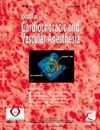跨越边界:利用左侧叶轮进行右室机械支持和术中经食管超声心动图的考虑。
IF 2.3
4区 医学
Q2 ANESTHESIOLOGY
Journal of cardiothoracic and vascular anesthesia
Pub Date : 2025-03-01
DOI:10.1053/j.jvca.2024.12.018
引用次数: 0
摘要
目的:在心源性休克的各种病因中,右心衰是导致死亡的主要原因。本病例系列概述了在需要三尖瓣修复或置换的病例中,使用Impella LD或5.5直接卸载右心室而不穿过三尖瓣的创新方法。设计:回顾性单中心评价。环境:单一三级保健大学医院。参与者:接受Impella LD或5.5次插入以获得右心室支持的患者。干预措施:Impella LD或5.5经肺动脉直接插入右心室。测量和主要结果:获得患者的基线、术中、术后即刻临床和超声心动图数据。在连续5例术前接受三尖瓣手术和叶轮置入术的严重右心衰患者中,有3例患者同时接受了左心手术。所有患者均在体外循环分离前预先插入Impella。4例患者在术后24小时内拔管,并在术后1天(POD)内使用Impella行走。到POD 10时,4例患者有足够的右心室恢复,可以进行Impella LD移植。一名患者死于感染性休克,右心室辅助装置仍在。1例患者在植入Impella装置29天后过渡到舒适措施。结论:在接受三尖瓣手术的患者中,左侧叶轮可用于支持右心室。它提供直接的右心室卸载,不穿过新更换或修复的三尖瓣,并允许早期活动。本文章由计算机程序翻译,如有差异,请以英文原文为准。
Crossing Boundaries: Utilizing Left-sided Impella for Right Ventricular Mechanical Support and Intraoperative Transesophageal Echocardiogram Considerations
Objective
Right ventricular failure is a leading cause of mortality among patients with various etiologies of cardiogenic shock. This case series outlines an innovative approach to directly unloading the right ventricle with the Impella LD or 5.5 without crossing the tricuspid valve in cases requiring tricuspid valve repair or replacement.
Design
Retrospective single-center review.
Setting
Single tertiary care university hospital.
Participants
Patients who underwent Impella LD or 5.5 insertions for right ventricular support.
Interventions
Impella LD or 5.5 inserted directly into the right ventricle via the pulmonary artery.
Measurements and Main Results
Patients’ baseline, intraoperative, and immediate postoperative clinical and echocardiographic data were obtained. Of the five consecutive patients with severe preoperative right ventricular failure who underwent surgical tricuspid valve procedures and Impella placement, three of the patients underwent concomitant left heart procedures. The Impella was preemptively inserted before separation from cardiopulmonary bypass in all patients. Four patients were extubated within the first 24 hours and ambulated with the Impella by postoperative day (POD) 3. By POD 10, four patients had sufficient right ventricular recovery to allow for Impella LD explant. One patient died due to septic shock with the right ventricular assist device still in place. One patient was transitioned to comfort measures 29 days after explant of the Impella device.
Conclusions
Left-sided Impella can be used to support the right ventricle in patients who have undergone surgical tricuspid valve procedures. It provides direct right ventricular unloading, does not cross a newly replaced or repaired tricuspid valve, and allows early ambulation.
求助全文
通过发布文献求助,成功后即可免费获取论文全文。
去求助
来源期刊
CiteScore
4.80
自引率
17.90%
发文量
606
审稿时长
37 days
期刊介绍:
The Journal of Cardiothoracic and Vascular Anesthesia is primarily aimed at anesthesiologists who deal with patients undergoing cardiac, thoracic or vascular surgical procedures. JCVA features a multidisciplinary approach, with contributions from cardiac, vascular and thoracic surgeons, cardiologists, and other related specialists. Emphasis is placed on rapid publication of clinically relevant material.

 求助内容:
求助内容: 应助结果提醒方式:
应助结果提醒方式:


